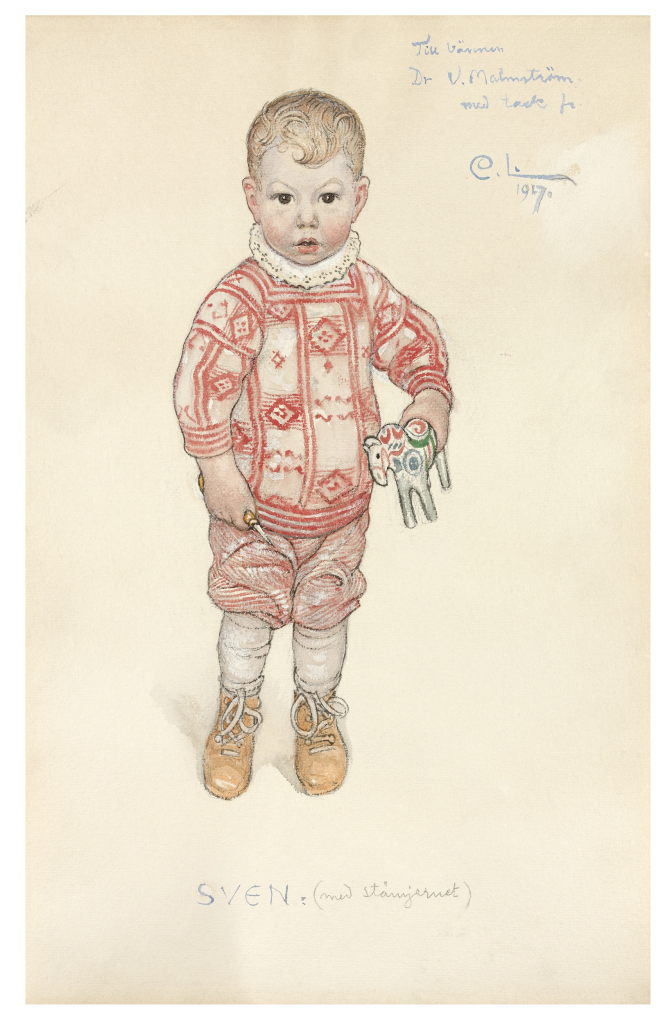Carl Larsson
(Stockholm 1853 - 1919 Falun)
Sven, 1917
Watercolour and pencil heightened with white on paper, 45.7 x 29 cm
Inscribed, dated and signed upper right Till vännen / Dr. V. Malmström / med tack fr. / C.L. / 1917 [To dear / Dr. V. Malmström / with thanks fr.(om) / C.L. / 1917], inscribed with the name of the sitter lower centre SVEN (med stämjernet)
Provenance:
Dr. Valdemar Malmström, Falun (presented by the artist to Malmström);
Thence by descent.
Literature:
Ulwa Neergaard, Carl Larsson. Signerat med pensel och penna, catalogue raisonné, Stockholm 1999, II, p. 164, no. 16891.
Exhibited:
Minnesutställning. Carl Larsson, Stockholm, Liljevalchs Konsthall, 6 March-5 April 1920, no. 338;
Carl Larsson. Vänner & ovänner, Stockholm, Nationalmuseum, 13 June-3 November 2013 (ex-catalogue).
Carl Larsson is probably the best-known Swedish artist of the late nineteenth century. His paintings are deeply characteristic of Swedish country life in the period. His large artistic output spans book illustration, printmaking, painting and drawing. He also completed a monumental fresco cycle for the entrance hall of the Nationalmuseum in Stockholm.
Larsson was born in Stockholm in 1853. At the age of only thirteen he was encouraged to enrol on a foundation course at the principskola run by the Royal Swedish Academy of Art in Stockholm. He was accepted as a regular student in 1869, completing his studies in 1876. He divided his time between Paris and Sweden in the years 1877 to 1882. Commercial success and any degree of public recognition were denied him for much of his early career. In the spring of 1882, Larsson visited the village of Grez-sur-Loing in the Seine-et-Marne. Here a group of Scandinavian artists had settled and an international colony of artists was in the process of forming. This visit was to mark a turning point in Larsson’s life and career. Inspired by the range of new artistic impulses available in Grez he wasted little time in jettisoning the academic approach to painting. Abandoning traditional painting in oil he turned to open-air painting. Watercolour was to be his preferred medium. His study of nature and engagement with the realist tendencies generated by modern plein-air painting in France helped him to rapid success: in 1883 he was awarded a medal at the Paris Salon. Public and institutional collectors were soon beating a path to his door. Many sales and commissions followed. In 1886 Larsson spent extensive periods in Paris and in Italy to study the art of monumental painting. In the same year he was invited by Pontus Fürstenberg, his patron, to visit Göteborg. He joined the newly established Artists’ Association and took up a post as professor at the Göteborg art school.2
Carl Larsson and his wife Karin moved to the small village of Sundborn in 1901. Adolf Bergöö, Karin Larsson’s father, had given the couple a house there which they renovated and furnished. Their aim was to unite art and ‘real life’ by making the house a work of art in itself. Larsson’s wife, their seven children and the house itself – known as Lilla Hyttnäs (Little Cottage) – were to be recurrent motifs in his depictions of home life.3
Portraits of children were a major focus of interest to Larsson and they occupy a central position in his oeuvre. After his own children had grown up he often had neighbours’ children sit for him. He usually presented the finished portraits to the children’s parents.4 This watercolour is a portrait of Sven Malmström, the son of a local doctor. The portrait was a gift to Dr. Malmström thanking him for treating Larsson’s daughter. The small blond boy, his large brown eyes firmly fixed on the viewer, is holding a wooden horse in his left hand and grasping a woodcarving knife in his right.
Larsson began to develop his own distinctive linear style in the mid 1890s. His practice was to outline each figure and object in black. In the present watercolour, executed in 1917, he has employed the same graphic technique. The child’s clothing is depicted predominantly in rust-red and his cheeks and lips in deep pink, creating a contrast to the untouched white of the watercolour paper.
1 Neergaard erroneously identifies the sitter as Sven Nordlund.
2 For details of Larsson’s biography, see Johann Georg Prinz Hohenzollern (ed.), Carl Larsson: Ein schwedisches Märchen, exhib. cat., Munich, Kunsthalle der Hypo-Kulturstiftung, Munich 2005, pp. 38-59.
3 See Larsson, 2005, op. cit., p. 138 and p. 140. In 1899 Larsson published an album of colour reproductions after watercolours depicting his own home. The album is titled Ett Hem (A Home). It gave the Swedish public visual insights into Larsson’s home and family life. The illustrations project the ideals of a comfortable atmosphere and a happy family.
4 Carl Larsson, Matts Larsson, 1911, watercolour on paper, 64 x 46 cm, signed and with a personal dedication, Stockholm, Nationalmuseum, inv. NMB 2514. The portrait was published in a volume of plates after portraits of children by Larsson. The book was titled Andras barn (Other People’s Children) and appeared in 1913.

